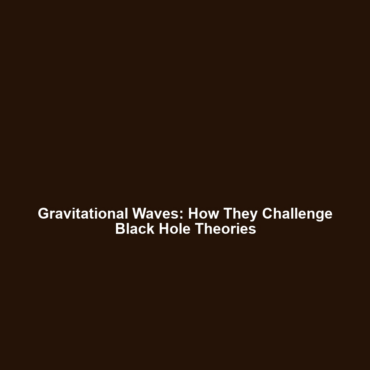How Gravitational Wave Data Has Challenged or Confirmed Existing Black Hole Theories
Introduction
Understanding how gravitational wave data has challenged or confirmed existing black hole theories is crucial for astrophysics. The detection of gravitational waves—ripples in spacetime caused by massive celestial events—has revolutionized our comprehension of black holes, providing evidence that either corroborates or disputes long-standing scientific theories. This intersection of phenomena signifies a leap in our understanding of the universe, challenging traditional views and opening doors to new scientific inquiries.
Key Concepts
The study of gravitational waves pertains to phenomena such as merging black holes, collisions, and neutron stars, showcasing several key concepts:
- Gravitational Waves: Created by accelerating masses, these waves travel at light speed through space and can be detected on Earth.
- Black Holes: Regions in space where gravitational forces prevent anything, including light, from escaping.
- Scientific Theories: Various theories about black hole formation and behavior have been tested against empirical gravitational wave data.
Research in gravitational waves has prompted scientists to refine existing black hole theories, such as the nature of their mergers and the mass distribution of black holes in the universe.
Applications and Real-World Uses
Gravitational wave data not only challenges existing black hole theories but also has practical applications, including:
- Astroinformatics: Analyzing large datasets from gravitational wave observations to unveil patterns in black hole mergers.
- Detecting Mergers: Identifying and characterizing merging black holes enhances our understanding of their populations.
- Theoretical Physics: Data from gravitational waves allows theorists to test predictions about gravity and spacetime.
These applications demonstrate how gravitational wave data is used in validating or modifying theories regarding black holes, thereby advancing the field of astrophysics.
Current Challenges
Many challenges persist in the study of gravitational waves and their implications on black hole theories. These include:
- Sensitivity and Noise: Gravitational wave detectors must operate in extremely low-noise environments, which can be technically challenging.
- Theoretical Uncertainties: Competing models of black hole physics create ambiguity that complicates interpretation of the data.
- Data Interpretation: Extracting relevant information from the noise requires sophisticated algorithms and methodologies.
Addressing these challenges is critical for future discoveries and validations in gravitational wave research.
Future Research and Innovations
Future innovations in observing gravitational waves promise to deepen our understanding of black hole dynamics. Advancements may include:
- Next-Generation Detectors: New detectors with enhanced sensitivity may uncover more subtle gravitational wave signals.
- Computational Models: Advanced simulations are likely to predict more accurately the behavior of black holes based on gravitational wave data.
- Interdisciplinary Approaches: Collaboration across various fields will foster innovative methods for analyzing and interpreting data.
These developments are poised to refine our grasp of gravitational waves, thus challenging and confirming black hole theories in unprecedented ways.
Conclusion
In conclusion, the interplay between gravitational wave data and black hole theories exemplifies the evolving nature of astrophysics. By challenging traditional models and confirming new hypotheses, scientists can advance our understanding of the universe. For continued exploration, readers are encouraged to learn more about related topics such as black hole formation and the technology behind gravitational wave detectors.

